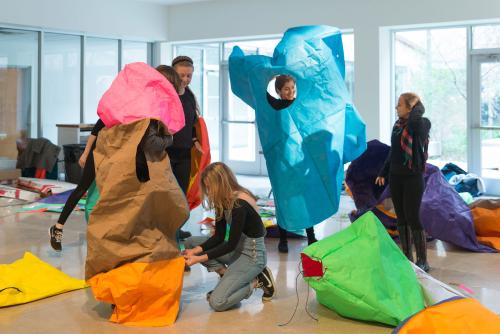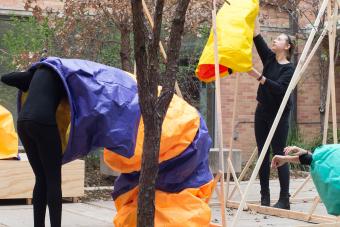
Undergraduate FAQ

Admissions
What’s required to apply?
- Your completed UT application
- Select one of our degrees as your first-choice major
- Short-Answer Responses (Freshman applicants) or Essay Topic D (External Transfer applicants)
- Art Education (BFA) and Studio Art (BA/BFA) applicants must submit a portfolio of 12-15 artworks with 2 works being completed from direct observation. See Preparing your Portfolio for further details.
Do you consider early applications?
No, the admissions deadlines are December 1 for Freshman applicants and March 1 for Transfer applicants. Submitting your application and portfolio earlier than the deadline will not affect the department’s admission decision.
Does the department only admit students in the top 10% of their class?
In the College of Fine Arts, we have a completely holistic review process. When considering students for our programs, we look at applicant portfolios, high school transcripts, admissions essays and test scores. If you are an Art Education or Studio Art applicant, one of the most important parts of your application is your portfolio. Art History applicants should focus on the quality of your short-answer responses.
What is your acceptance rate?
Our programs are highly competitive and acceptance rate varies by year and degree. The best way to prepare is to submit the absolute best portfolio and admissions essays that you can.
Can I apply to two majors at the same time?
No. You can only apply to one major at a time. You can declare a second major or minor once you are a current student.

Portfolios
What makes a portfolio outstanding?
An excellent portfolio is a balance of three important things: your technique/technical ability, your creativity, and what makes you unique. Include whatever you believe to be your strongest work in any or many media. This could include, but is not limited to, 2D or 3D works, digital works, time-based pieces, performance art, etc. But if you have only been able to study a limited number of media, put together a range of works from those for submission. We just want to see what you think is your strongest artwork.
When documenting your work, make sure the pieces are well lit, your photos or scans are high-resolution to show detail and clarity, and the digital images are cropped exactly to the edge of the canvas/paper.
What’s an observational drawing?
An observational drawing is not made from a grid or photograph. It’s a drawing done from life. Some examples include still-life drawings, gesture studies, and architectural or perspective drawings.
I’ve done a lot of creative things outside of my studio art classes. Can I include those works in my portfolio?
Yes! We are interested in getting to know you and seeing a wide variety of hands-on projects. Have you worked in a woodshop or welded? Are you interested in building virtual worlds? Have you designed a set or costume for a performance? We’re interested in all varieties of work, from clay modeling and crafts, to landscaping and jewelry design.
What if I have great ideas, but I don’t have the money or resources to bring them to life?
That’s ok! Past applicants have shared their ideas as sketches or plans for future projects. We are excited about these ideas too!
Are there any things I should consider leaving out of my portfolio?
Avoid a portfolio full of celebrity portraits or copies of popular anime/cartoon characters. A few of these are all right, but we want to see your original works of art and experience your ideas. School projects are fine as well.
I’m a photographer. Can I submit only photographs in my portfolio?
We do not have a photography program, but rather offer photography as an area of study. In our Studio Art program, students select a track that combines three different disciplines, so students are able to focus on various facets of the arts as opposed to having one single concentration. This is an excellent program for artists who would like to develop photography work and a photography practice, but is not well suited for students seeking a photography degree exclusively. You want your portfolio to demonstrate works in multiple media and limit the number of photography pieces that you submit.
Can I see an example portfolio?
No, because this process should be unique to your background and ideas. There’s no right or wrong way to create a portfolio.
How much can I say about my work?
When submitting your portfolio, you will also be asked to include an artist statement where you may go into detail about your artworks and ideas. Additionally, when submitting your digital files you will have space to include a title, dimensions, medium, and description of the work.
Who reviews my portfolio?
Each degree program has an admissions committee made up of faculty from that program. This committee will review portfolios, essays, and application materials.
How important is the portfolio in the application process?
The portfolio is one of the most important components of your application. Please take your time in submitting a thoughtful, well-prepared portfolio.

Academics
Can I minor or double-major?
Yes, students are able to obtain a minor or a simultaneous second major in colleges across the university. To double-major, students should begin in their first-choice major, and once they have acquired 30 credit hours at UT (sophomore year), they can then apply to the program of their desired “second” or simultaneous major. Students must have a competitive GPA, and it is entirely at the discretion of the other college/school within the university to admit students into their program. The University of Texas at Austin offers numerous opportunities for students to enhance their educational experience. We encourage you to explore the Minors & Certificates page to learn about academic opportunities beyond your major.
Visiting
I want to tour the department. How can I arrange that?
We encourage prospective applicants to visit campus and our department to get a sense of our programs, student body, and the work/projects that our students are producing and are part of. Information Sessions and Tours are held regularly. Please review the Plan a Visit page for more information.
When visiting campus, where should I park?
See the Maps & Parking page for more information.
Financial
Does the department offer scholarships?
See the Tuition & Scholarships page for information about undergraduate costs, as well as scholarships and other options for financial support.




